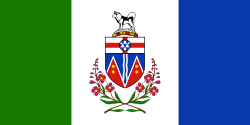Yukon
territory of Canada From Wikipedia, the free encyclopedia
The Yukon is a territory of Canada, north of British Columbia, west of the Northwest Territories, and east of the American state of Alaska. Its population is around 47,000. Most of the territory's people live in the capital of Whitehorse. Many of the people are native Canadians (First Nations).
Yukon
| |
|---|---|
|
| |
| Coordinates: 63°N 135°W[1] | |
| Country | Canada |
| Confederation | June 13, 1898 (9th) |
| Capital | Whitehorse |
| Largest city | Whitehorse |
| Largest metro | Whitehorse |
| Government | |
| • Type | Parliamentary system |
| • Commissioner | Adeline Webber |
| • Premier | Ranj Pillai (Liberal) |
| Legislature | Yukon Legislative Assembly |
| Federal representation | Parliament of Canada |
| House seats | 1 of 338 (0.3%) |
| Senate seats | 1 of 105 (1%) |
| Area | |
| • Total | 482,443 km2 (186,272 sq mi) |
| • Land | 474,391 km2 (183,163 sq mi) |
| • Water | 8,052 km2 (3,109 sq mi) 1.7% |
| • Rank | Ranked 9th |
| 4.8% of Canada | |
| Population (2021) | |
| • Total | 40,232[3] |
| • Estimate (2025 Q1) | 47,126[4] |
| • Rank | Ranked 12th |
| • Density | 0.08/km2 (0.2/sq mi) |
| Demonyms | Yukoner FR: Yukonnais(e) |
| Official languages | |
| GDP | |
| • Rank | 13th |
| • Total (2017) | C$3.089 billion[6] |
| • Per capita | C$75,141 (3rd) |
| HDI | |
| • HDI (2021) | 0.930[7] — Very high (4th) |
| Time zone | UTC−07:00 |
| Postal abbr. | YT |
| Postal code prefix | Y |
| ISO 3166 code | CA-YT |
| Flower | Fireweed |
| Tree | Subalpine fir[8] |
| Bird | Common raven |
| Rankings include all provinces and territories | |
The Yukon became a territory in 1898. It was part of the Northwest Territories from 1870 to 1898. Many people came to live in the Yukon during the Yukon Gold Rush of the 1890s.
Mount Logan, at 5959 metres above sea level, is Canada's highest mountain.
The most important industry in the Yukon is mining.
References
Wikiwand - on
Seamless Wikipedia browsing. On steroids.


